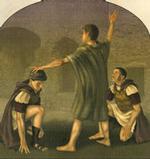Heroic virtue: memories of John Paul II
By Phil Lawler ( bio - articles - email ) | Jan 14, 2011
When you think of Pope John Paul II, what memories come first to your mind?
For me, there is Christmas Eve in the year 2000, standing in the pouring rain in St. Peter’s Square surrounded by my family, at the culminating moment of our Jubilee pilgrimage, waiting for the Pope to celebrate midnight Mass. When he finally arrived, clad in gold vestments, our youngest child Bridget, who was 3 at the time, leaned down from her perch on my shoulders and shouted over the pounding of the raindrops: “I just love him!” She spoke for us all.
But that’s just my personal memory. I have others, almost as vivid, that I share with millions of other Catholics. Oddly enough, of the four memories that spring immediately to mind, only two were mentioned in the Vatican Radio story about the decree on the late Pope’s beatification.
- First I remember John Paul II standing beside General Wojciech Jaruzelski, on a podium in front of an enormous crowd. General Jaruzelski is speaking from a prepared text. The papers are shaking in his hand. There is no discernible breeze. The head of the Polish Communist regime was quite obviously rattled by the Pope’s presence. And as history would soon prove, he had reason to be. The papacy of John Paul II was the bane of Soviet Communism. It would be foolish to suggest that John Paul II alone caused the collapse of the Iron Curtain—history is never that simple—but he was certainly one of the most important actors in the drama that brought down a murderous empire. I find it astonishing that his pivotal role in this great historic development is not even mentioned in the decree issued by the Congregation for the Causes of Saints.
- Second I think of the late Pope’s introduction of the Luminous Mysteries of the Rosary. I vividly recall my stunned reaction: “Can he do that? Can a Pope change the Rosary?” Frankly I was appalled. But I did my best to be docile, set aside my initial reaction, and pray the new mysteries. That effort quickly paid dividends for my spiritual life, and I recognized that John Paul II had a special gift for promoting Marian devotion: a gift that is mentioned in the Congregation’s decree.
- Next I see the image of the Pope on his kneels at the door of St. Peter’s basilica, as he opened the Jubilee Year. Describing the moment in The End and the Beginning, George Weigel comments: “It took a hardened heart not to recognize that here was a man living the supreme moment of his life…” Just so. If the struggle with Communism marked the first phase of his pontificate, John Paul II devoted the second phase to the preparation for, and celebration of, the Jubilee Year. He was so keenly conscious of his role in leading the Church into the 3rd Christian millennium, he made the year 2000 a watershed for the faithful. I still believe, hope, and pray that another 500 years from now, historians will recognize the Jubilee Year as a turning point, marking the end of a long trend that led to the blood-stained secularism of the 20th century, and the beginning of a new resurgence of active Christian evangelism. The Congregation for the Causes of Saints mentions the Jubilee, too, in its summation of the late Pope’s life.
- Last I remember the scene in St. Peter’s Square on April 2, 2005. The whole world was watching, participating in a televised vigil, as the great Pontiff breathed his last. Has the death of any other human being ever been so widely anticipated, publicized, or mourned? No; it isn’t even close. Having led the Church through the Jubilee Year, John Paul II devoted his final years to a very personal Christian witness: He allowed the world to watch as age and disease weakened, debilitated, and finally killed him. He showed us, by concrete example, the Christian dignity of suffering. I find it most surprising of all that this powerful witness is not mentioned in the decree. When the announcement of the Pope’s death finally came, a gentle, subdued applause rippled through St. Peter’s Square. The people were testifying, in the only way they could, that the Pope’s final witness had been powerful. His death, like his life, had shown the world his “heroic virtue.”
All comments are moderated. To lighten our editing burden, only current donors are allowed to Sound Off. If you are a current donor, log in to see the comment form; otherwise please support our work, and Sound Off!
-
Posted by: Contrary1995 -
Jan. 17, 2011 11:28 AM ET USA
This is a wonderful reflection. The fact that the supporters of Queen Isabella and the readers of the National Catholic Reporter both cannot embrace John Paul's canonization tesitifies to the fact that on the big issues John Paul acted as the Spirit led him. He was neither Left nor Right.
-
Posted by: koinonia -
Jan. 15, 2011 11:54 AM ET USA
Ours is an age of sentimentality. Our emotions are a vital component of who we are, but they are nothing if not "troublesome." I believe the haste to canonize Pope John Paul II does no one any favors. The unjust omission of his role in the downfall of communism is a prime example. This process is very important and highly publicized. Queen Isabel the Catholic is still on hold after 500 years. Let's slow down and do it right. What's the hurry?








